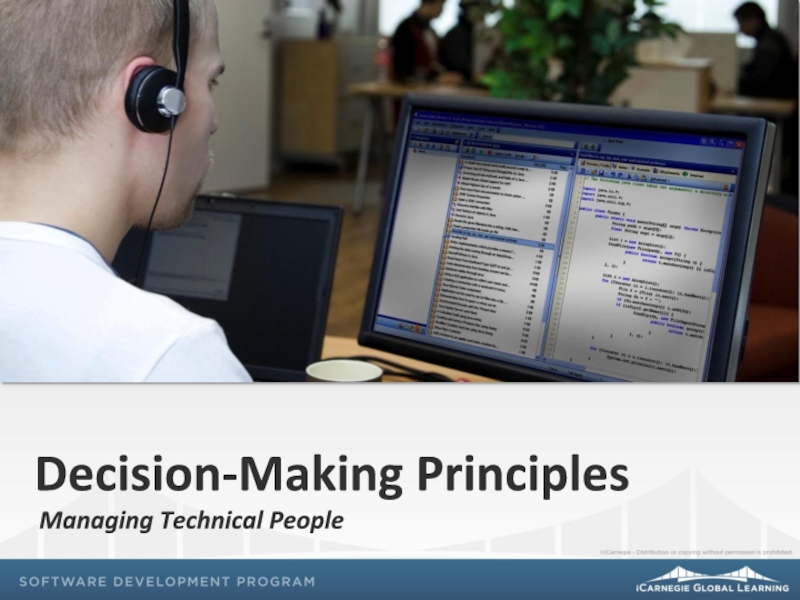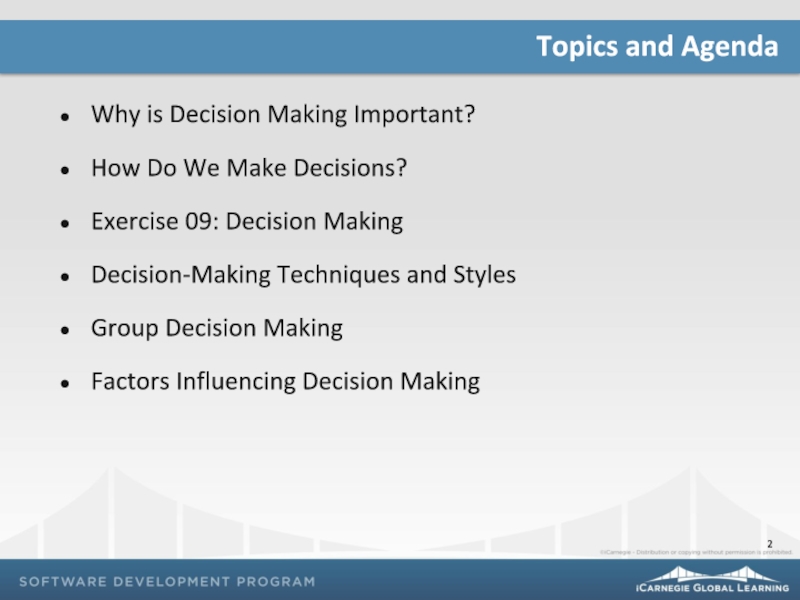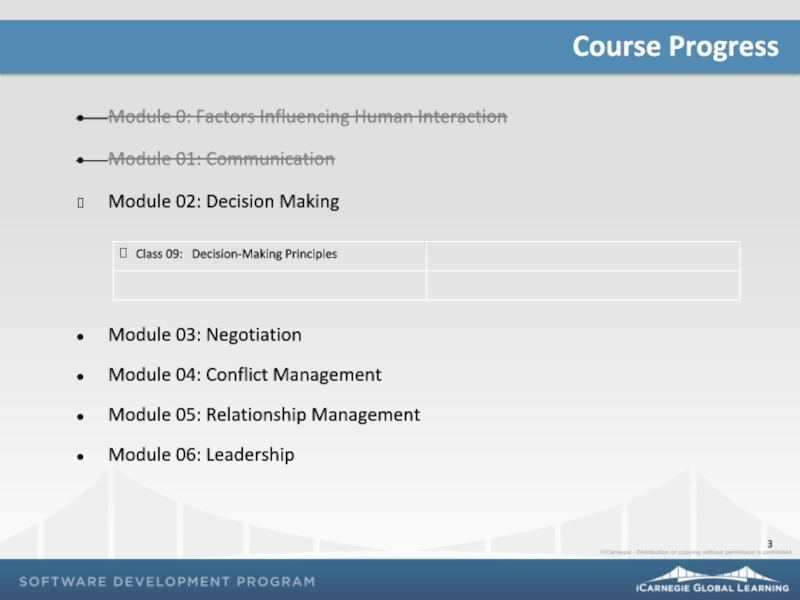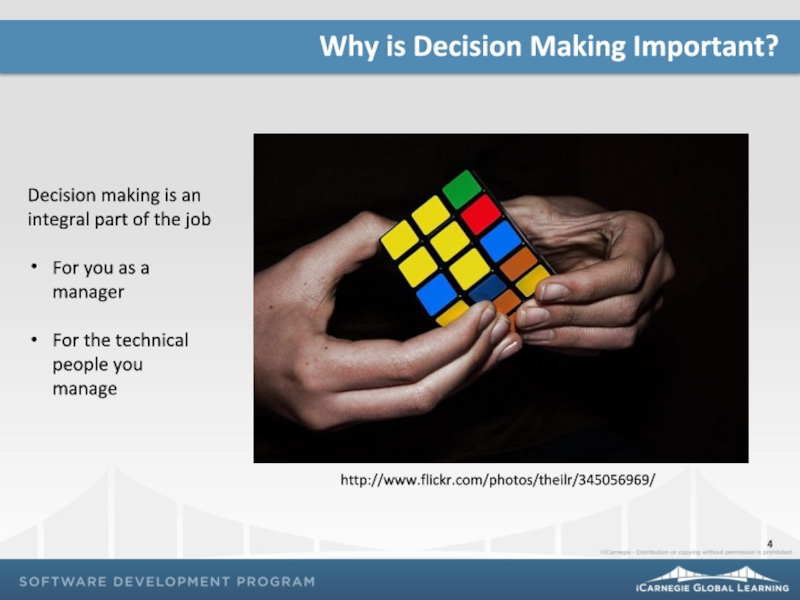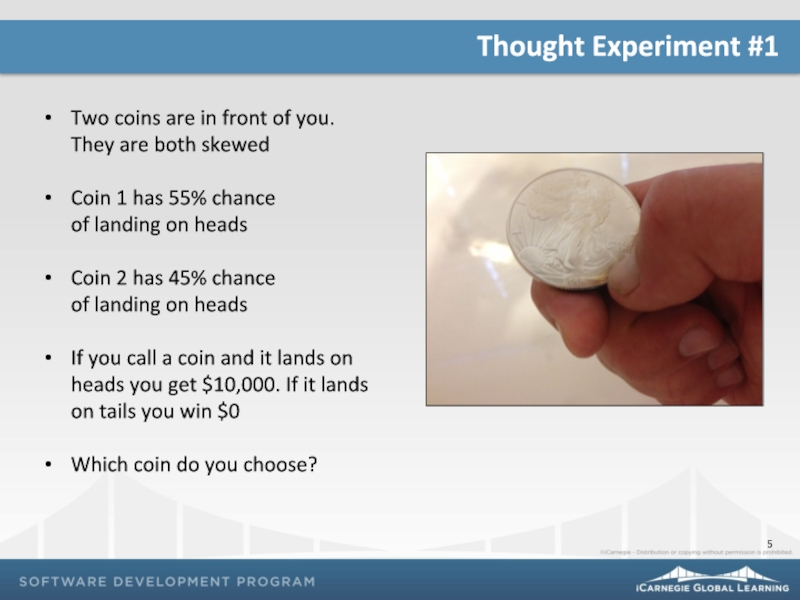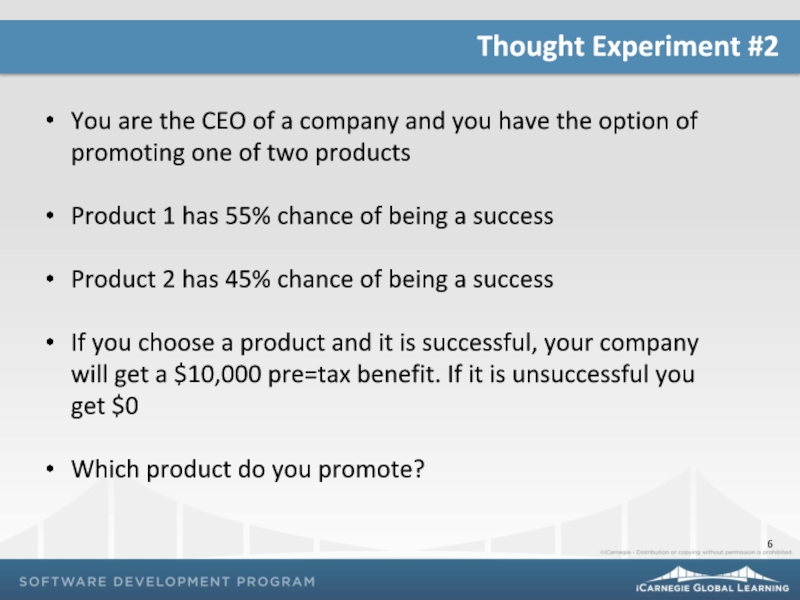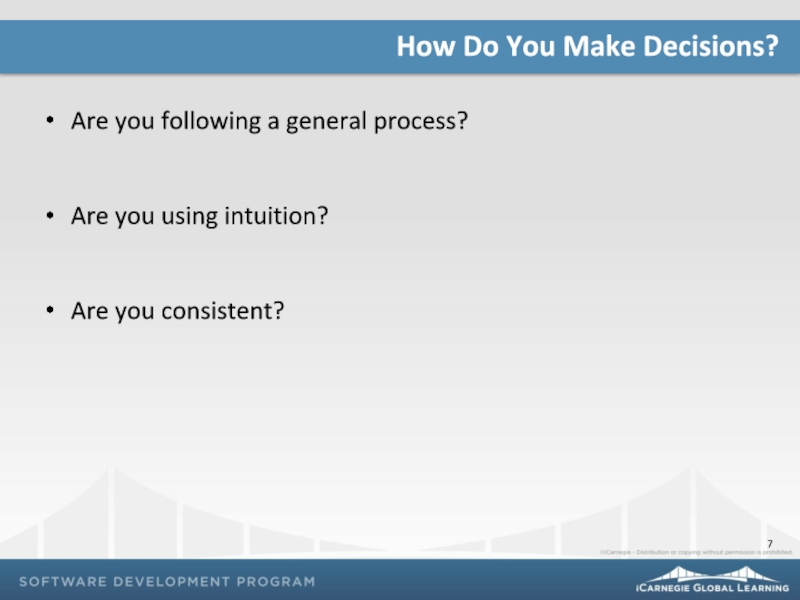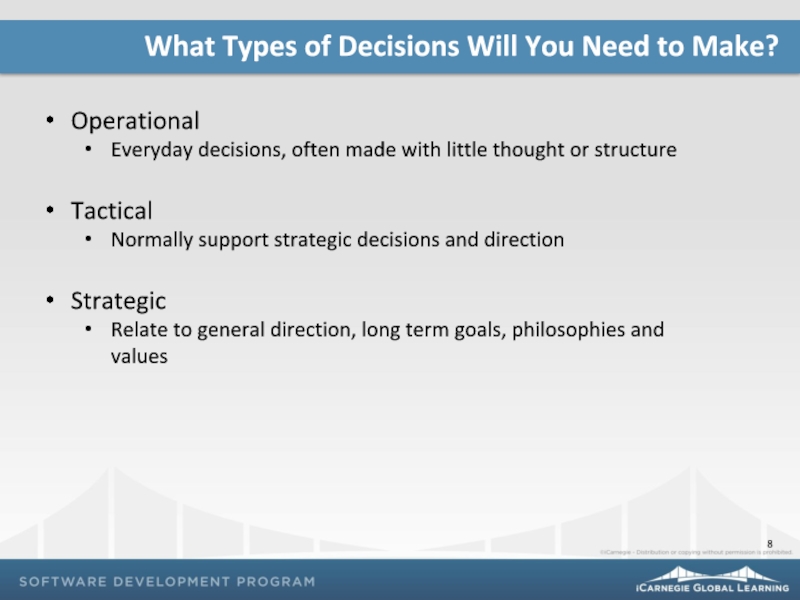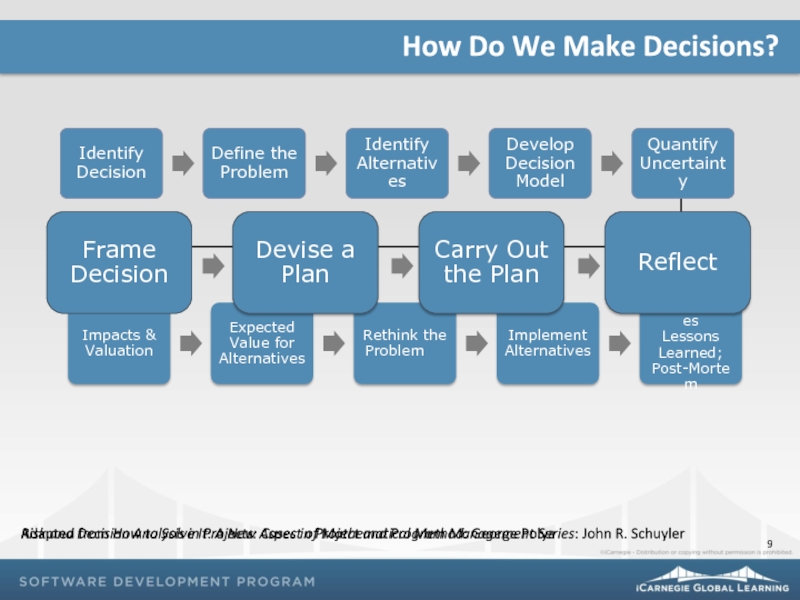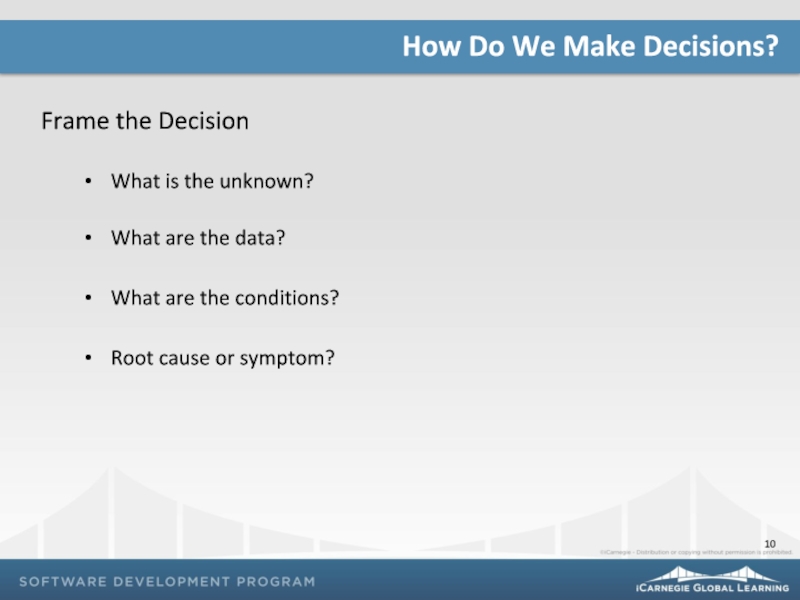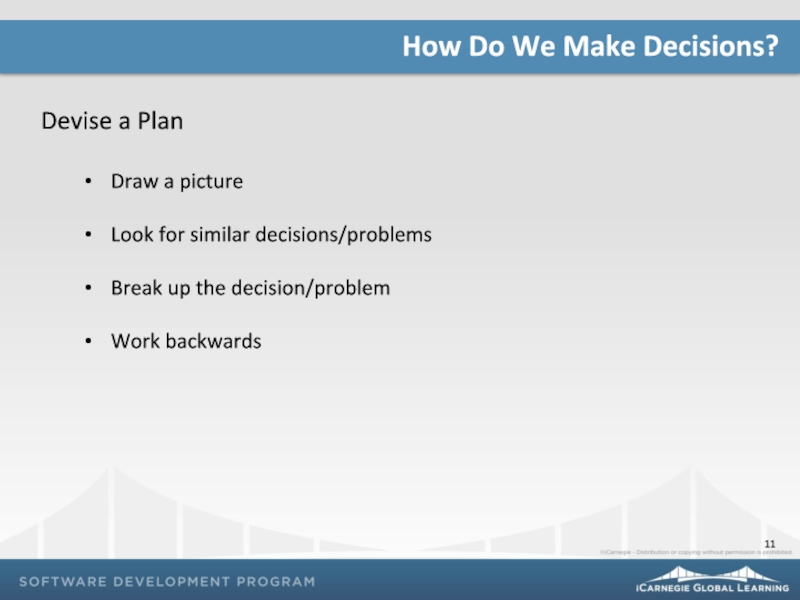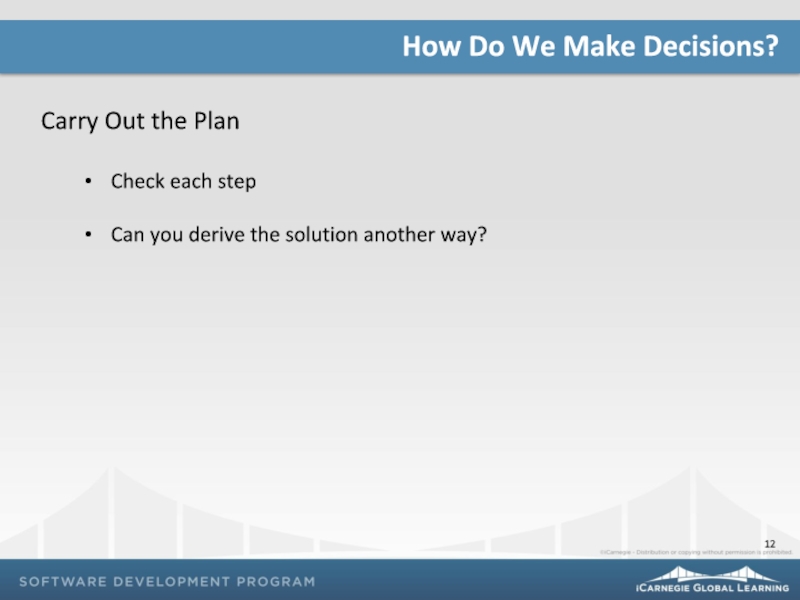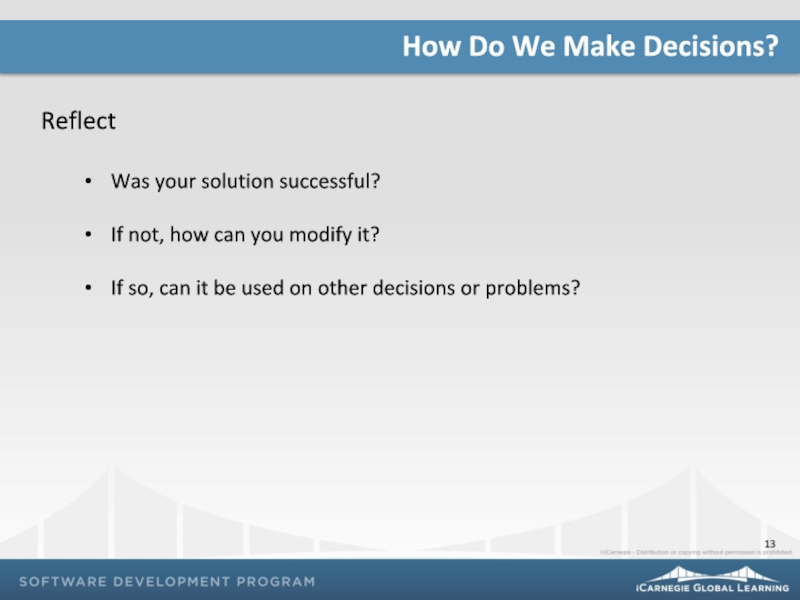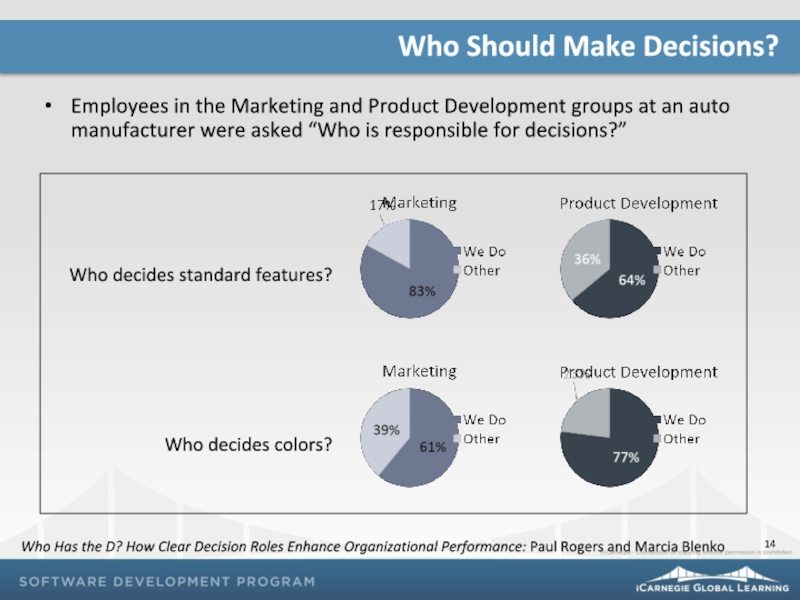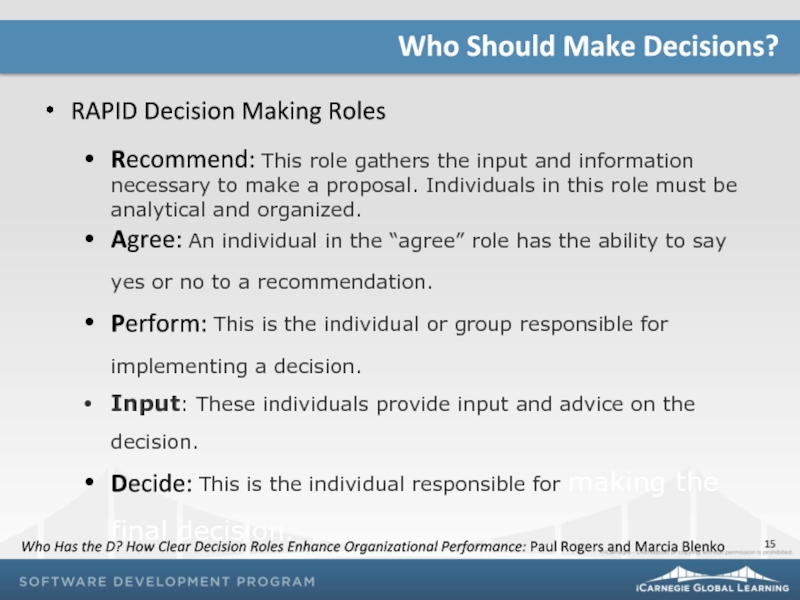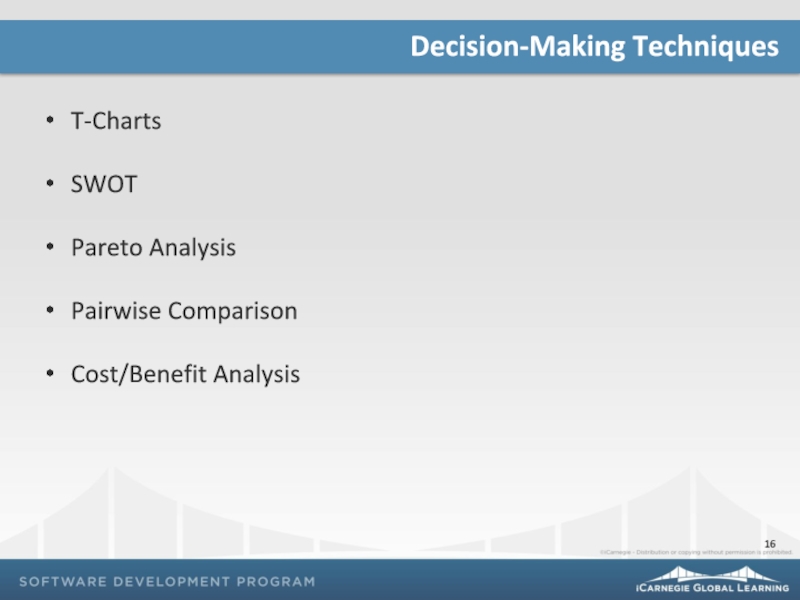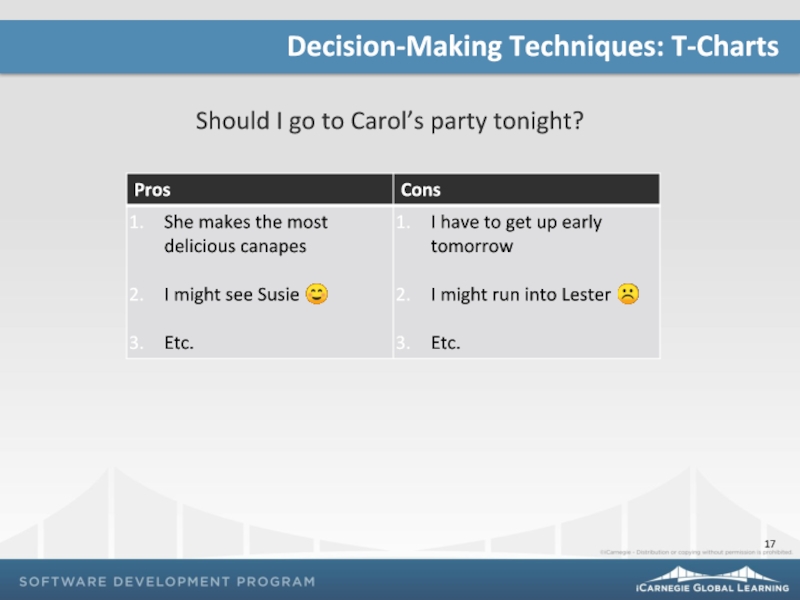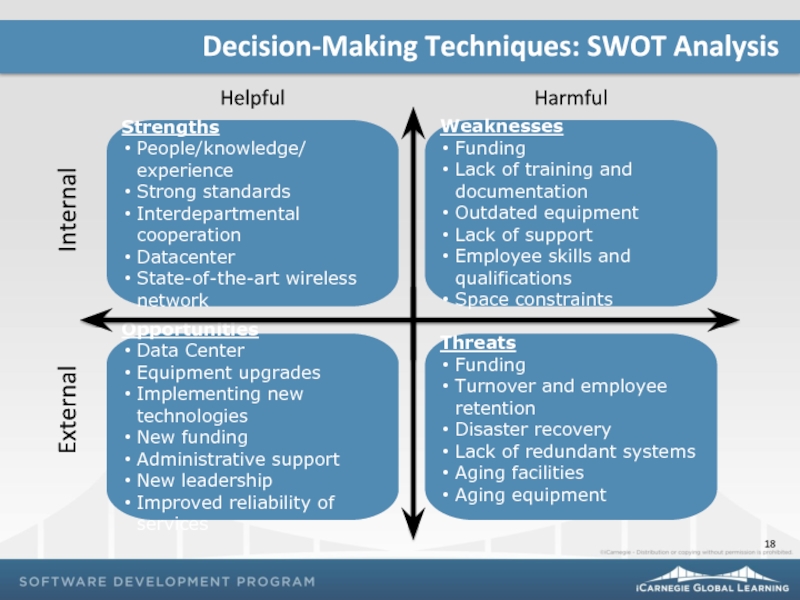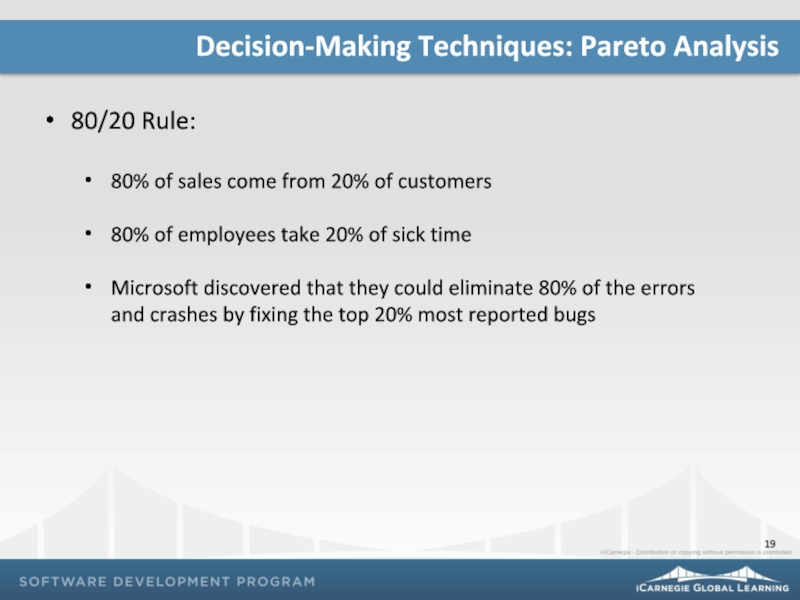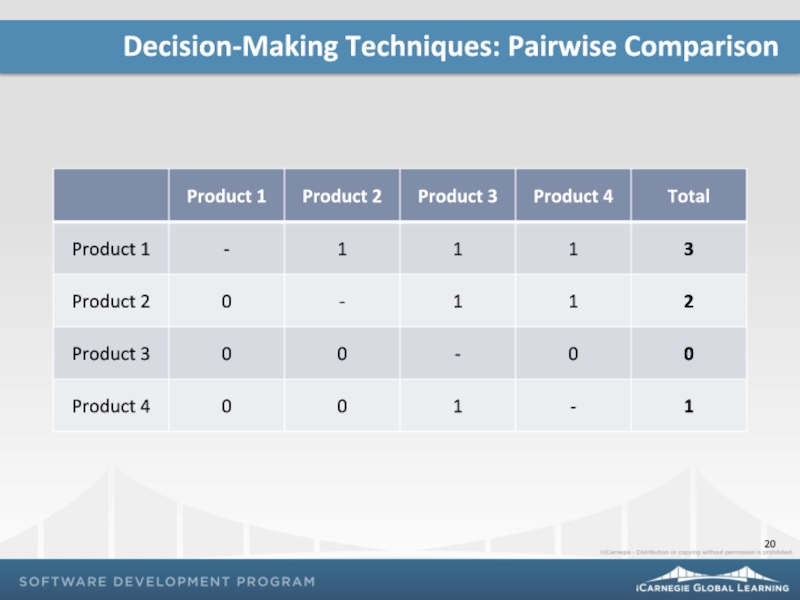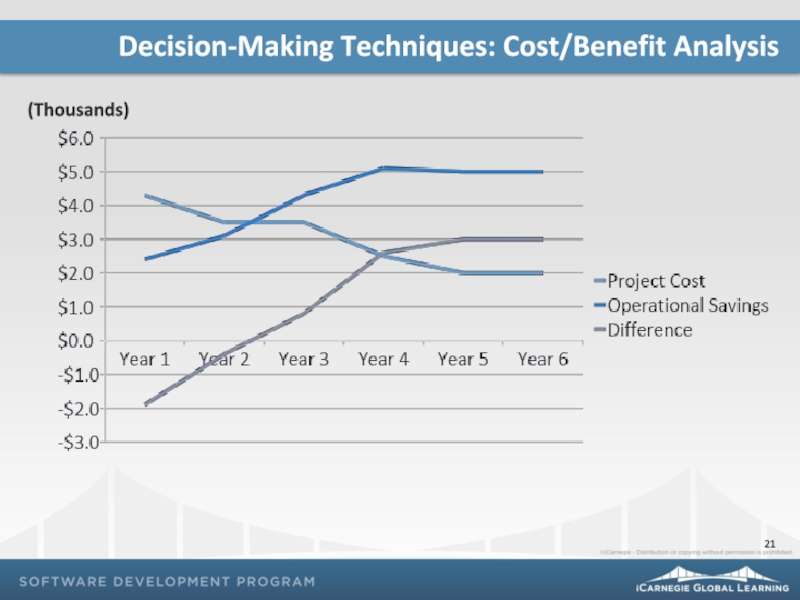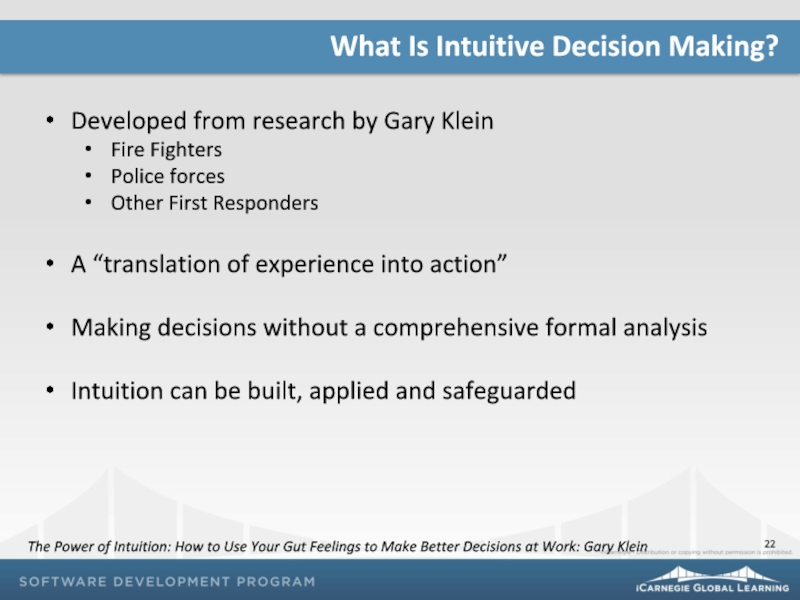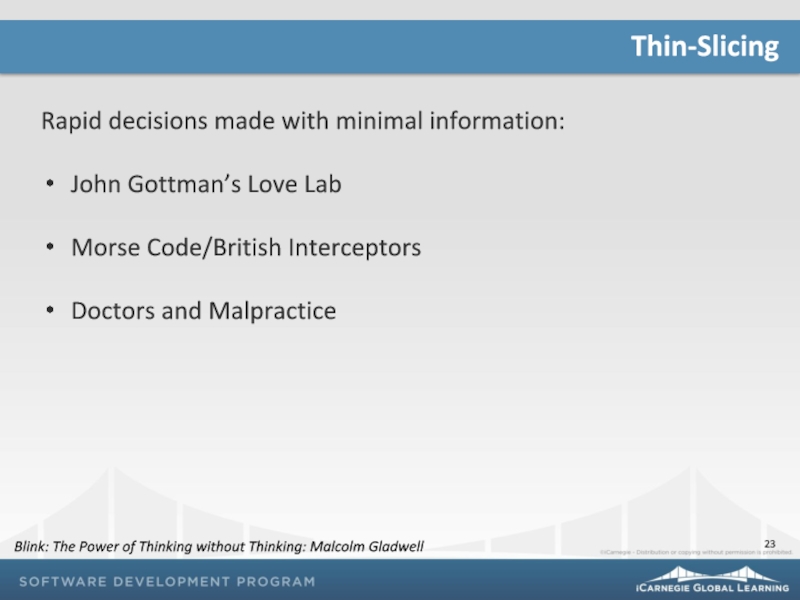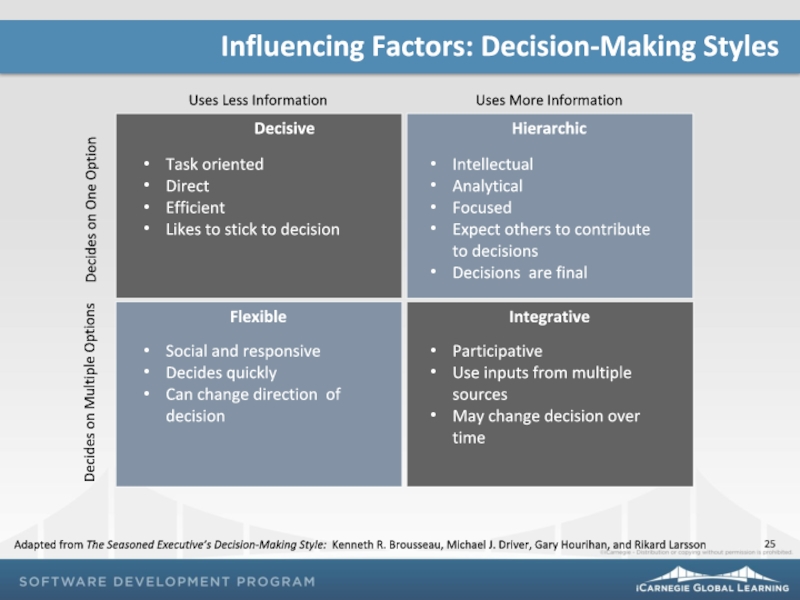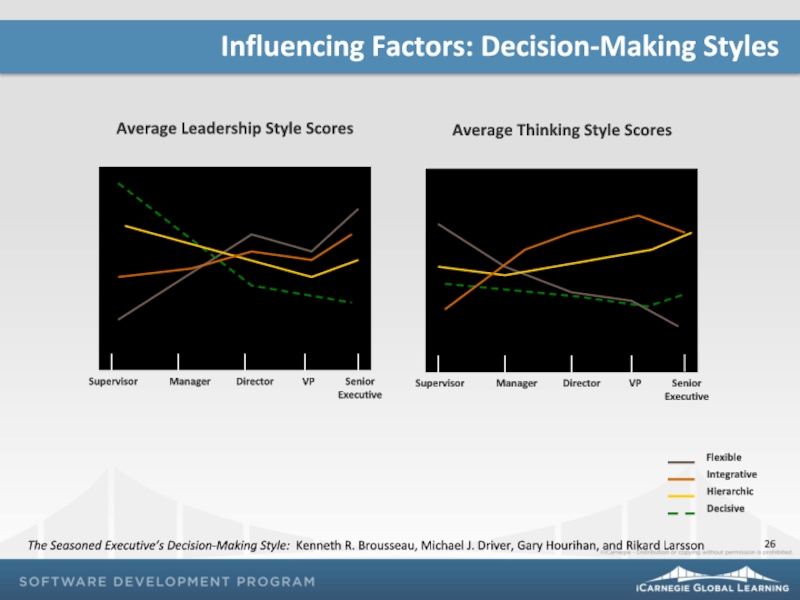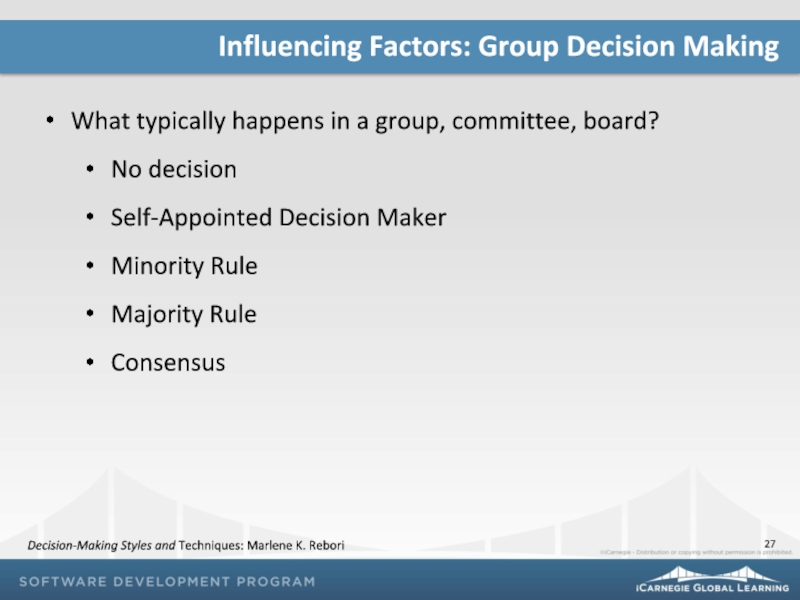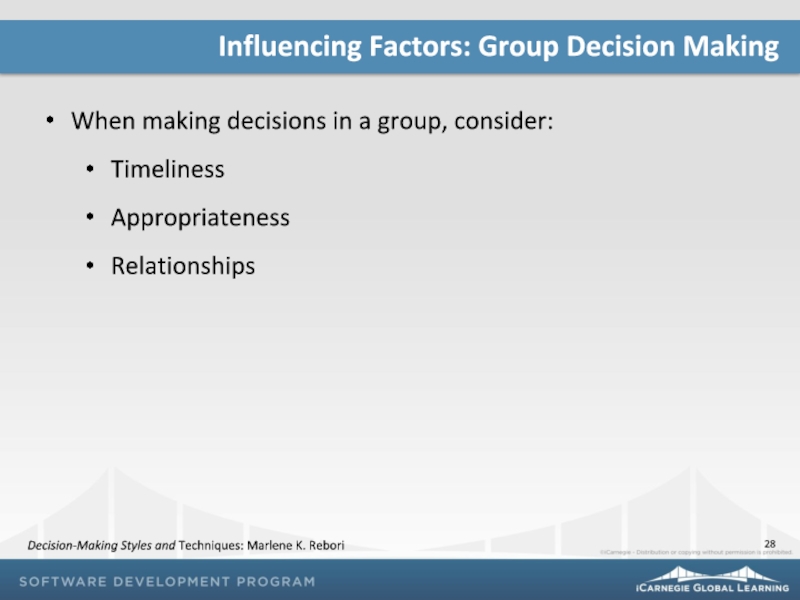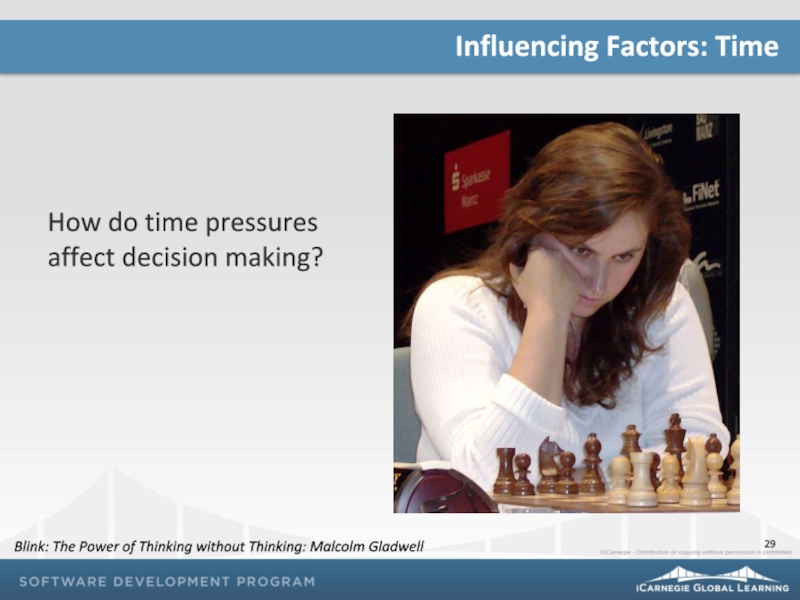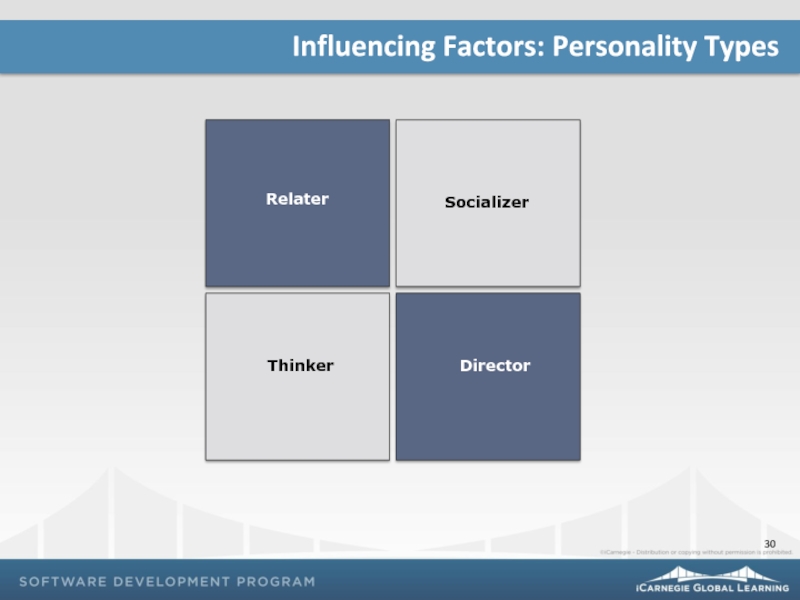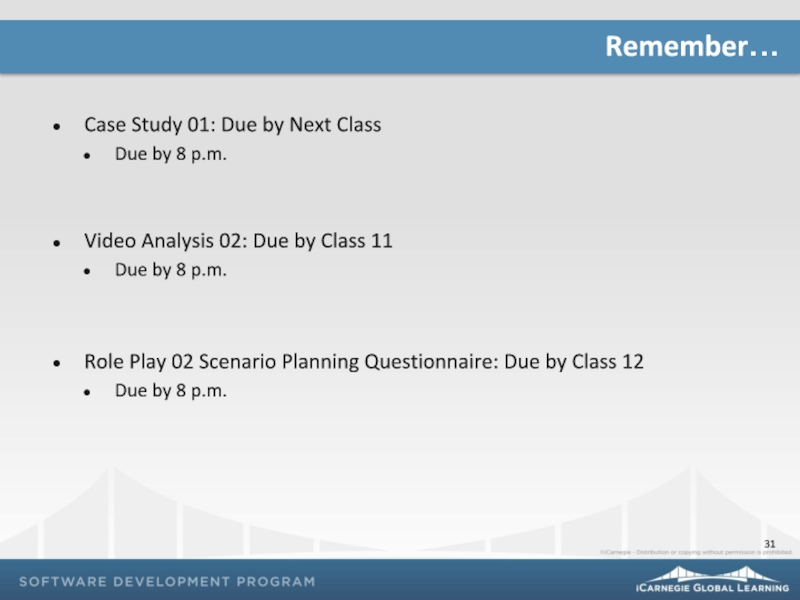- Главная
- Разное
- Дизайн
- Бизнес и предпринимательство
- Аналитика
- Образование
- Развлечения
- Красота и здоровье
- Финансы
- Государство
- Путешествия
- Спорт
- Недвижимость
- Армия
- Графика
- Культурология
- Еда и кулинария
- Лингвистика
- Английский язык
- Астрономия
- Алгебра
- Биология
- География
- Детские презентации
- Информатика
- История
- Литература
- Маркетинг
- Математика
- Медицина
- Менеджмент
- Музыка
- МХК
- Немецкий язык
- ОБЖ
- Обществознание
- Окружающий мир
- Педагогика
- Русский язык
- Технология
- Физика
- Философия
- Химия
- Шаблоны, картинки для презентаций
- Экология
- Экономика
- Юриспруденция
Decision-making principles презентация
Содержание
- 1. Decision-making principles
- 2. Why is Decision Making Important? How
- 3. Course Progress Module 0: Factors Influencing
- 4. Why is Decision Making Important? Decision
- 5. Thought Experiment #1 Two coins
- 6. Thought Experiment #2 You are
- 7. How Do You Make Decisions?
- 8. What Types of Decisions Will You
- 9. How Do We Make Decisions? Risk
- 10. How Do We Make Decisions? Frame
- 11. How Do We Make Decisions? Devise
- 12. How Do We Make Decisions? Carry
- 13. How Do We Make Decisions? Reflect
- 14. Who Should Make Decisions? Who decides
- 15. Who Should Make Decisions? Who Has
- 16. Decision-Making Techniques T-Charts SWOT
- 17. Decision-Making Techniques: T-Charts Should I go to Carol’s party tonight?
- 18. Decision-Making Techniques: SWOT Analysis Strengths People/knowledge/
- 19. Decision-Making Techniques: Pareto Analysis 80/20 Rule:
- 20. Decision-Making Techniques: Pairwise Comparison
- 21. Decision-Making Techniques: Cost/Benefit Analysis (Thousands)
- 22. What Is Intuitive Decision Making? Developed
- 23. Thin-Slicing Rapid decisions made with minimal
- 24. What Is Intuitive Decision Making? Situation
- 25. Influencing Factors: Decision-Making Styles
- 26. Influencing Factors: Decision-Making Styles The Seasoned
- 27. Influencing Factors: Group Decision Making What
- 28. Influencing Factors: Group Decision Making When
- 29. Influencing Factors: Time How do
- 30. Influencing Factors: Personality Types Socializer Director Thinker Relater
- 31. Case Study 01: Due by Next
Слайд 2
Why is Decision Making Important?
How Do We Make Decisions?
Exercise 09: Decision
Decision-Making Techniques and Styles
Group Decision Making
Factors Influencing Decision Making
Topics and Agenda
Слайд 3
Course Progress
Module 0: Factors Influencing Human Interaction
Module 01: Communication
Module
Module 03: Negotiation
Module 04: Conflict Management
Module 05: Relationship Management
Module 06: Leadership
Слайд 4
Why is Decision Making Important?
Decision making is an integral part of
For you as a manager
For the technical people you manage
http://www.flickr.com/photos/theilr/345056969/
Слайд 5
Thought Experiment #1
Two coins are in front of you.
They
Coin 1 has 55% chance of landing on heads
Coin 2 has 45% chance of landing on heads
If you call a coin and it lands on heads you get $10,000. If it lands on tails you win $0
Which coin do you choose?
Слайд 6
Thought Experiment #2
You are the CEO of a company and
Product 1 has 55% chance of being a success
Product 2 has 45% chance of being a success
If you choose a product and it is successful, your company will get a $10,000 pre=tax benefit. If it is unsuccessful you get $0
Which product do you promote?
Слайд 7
How Do You Make Decisions?
Are you following a general process?
Are
Are you consistent?
Слайд 8
What Types of Decisions Will You Need to Make?
Operational
Everyday decisions, often
Tactical
Normally support strategic decisions and direction
Strategic
Relate to general direction, long term goals, philosophies and values
Слайд 9
How Do We Make Decisions?
Risk and Decision Analysis in Projects: Cases
Frame
Decision
Devise a Plan
Carry Out the Plan
Reflect
Adapted from How to Solve It: A New Aspect of Mathematical Method: George Polya
Слайд 10
How Do We Make Decisions?
Frame the Decision
What is the unknown?
What are
What are the conditions?
Root cause or symptom?
Слайд 11
How Do We Make Decisions?
Devise a Plan
Draw a picture
Look for similar
Break up the decision/problem
Work backwards
Слайд 12
How Do We Make Decisions?
Carry Out the Plan
Check each step
Can you
Слайд 13
How Do We Make Decisions?
Reflect
Was your solution successful?
If not, how can
If so, can it be used on other decisions or problems?
Слайд 14
Who Should Make Decisions?
Who decides standard features?
Who Has the D? How
Who decides colors?
Employees in the Marketing and Product Development groups at an auto manufacturer were asked “Who is responsible for decisions?”
Слайд 15
Who Should Make Decisions?
Who Has the D? How Clear Decision Roles
RAPID Decision Making Roles
Recommend: This role gathers the input and information necessary to make a proposal. Individuals in this role must be analytical and organized.
Agree: An individual in the “agree” role has the ability to say yes or no to a recommendation.
Perform: This is the individual or group responsible for implementing a decision.
Input: These individuals provide input and advice on the decision.
Decide: This is the individual responsible for making the final decision.
Слайд 16
Decision-Making Techniques
T-Charts
SWOT
Pareto Analysis
Pairwise Comparison
Cost/Benefit Analysis
Слайд 18
Decision-Making Techniques: SWOT Analysis
Strengths
People/knowledge/
experience
Strong standards
Interdepartmental cooperation
Datacenter
State-of-the-art wireless network
Weaknesses
Funding
Lack of training and
Outdated equipment
Lack of support
Employee skills and qualifications
Space constraints
Opportunities
Data Center
Equipment upgrades
Implementing new technologies
New funding
Administrative support
New leadership
Improved reliability of services
Threats
Funding
Turnover and employee retention
Disaster recovery
Lack of redundant systems
Aging facilities
Aging equipment
Helpful
Harmful
Internal
External
Слайд 19
Decision-Making Techniques: Pareto Analysis
80/20 Rule:
80% of sales come from 20% of
80% of employees take 20% of sick time
Microsoft discovered that they could eliminate 80% of the errors and crashes by fixing the top 20% most reported bugs
Слайд 22
What Is Intuitive Decision Making?
Developed from research by Gary Klein
Fire Fighters
Police
Other First Responders
A “translation of experience into action”
Making decisions without a comprehensive formal analysis
Intuition can be built, applied and safeguarded
The Power of Intuition: How to Use Your Gut Feelings to Make Better Decisions at Work: Gary Klein
Слайд 23
Thin-Slicing
Rapid decisions made with minimal information:
John Gottman’s Love Lab
Morse Code/British Interceptors
Doctors
Blink: The Power of Thinking without Thinking: Malcolm Gladwell
Слайд 24
What Is Intuitive Decision Making?
Situation
Observe
Cues
Recognize
Patterns
Choose
Course of
Action
The Power of Intuition:
Слайд 25
Influencing Factors: Decision-Making Styles
Decides on Multiple Options
Decides on One Option
Uses More
Uses Less Information
Decisive
Flexible
Integrative
Hierarchic
Task oriented
Direct
Efficient
Likes to stick to decision
Participative
Use inputs from multiple sources
May change decision over time
Intellectual
Analytical
Focused
Expect others to contribute to decisions
Decisions are final
Social and responsive
Decides quickly
Can change direction of decision
Adapted from The Seasoned Executive’s Decision-Making Style: Kenneth R. Brousseau, Michael J. Driver, Gary Hourihan, and Rikard Larsson
Слайд 26
Influencing Factors: Decision-Making Styles
The Seasoned Executive’s Decision-Making Style: Kenneth R. Brousseau,
Слайд 27
Influencing Factors: Group Decision Making
What typically happens in a group, committee,
No decision
Self-Appointed Decision Maker
Minority Rule
Majority Rule
Consensus
Decision-Making Styles and Techniques: Marlene K. Rebori
Слайд 28
Influencing Factors: Group Decision Making
When making decisions in a group, consider:
Timeliness
Appropriateness
Relationships
Decision-Making
Слайд 29
Influencing Factors: Time
How do time pressures affect decision making?
Blink: The
Слайд 31
Case Study 01: Due by Next Class
Due by 8 p.m.
Video Analysis 02: Due by Class 11
Due by 8 p.m.
Role Play 02 Scenario Planning Questionnaire: Due by Class 12
Due by 8 p.m.
Remember…
